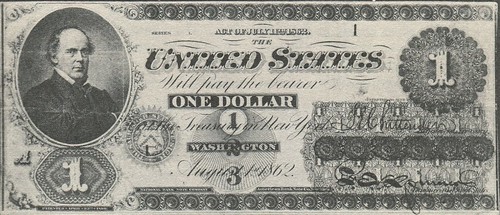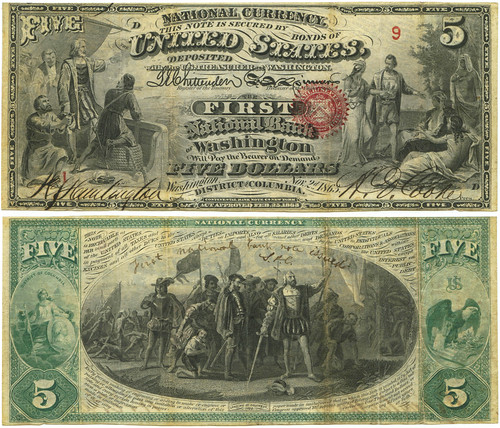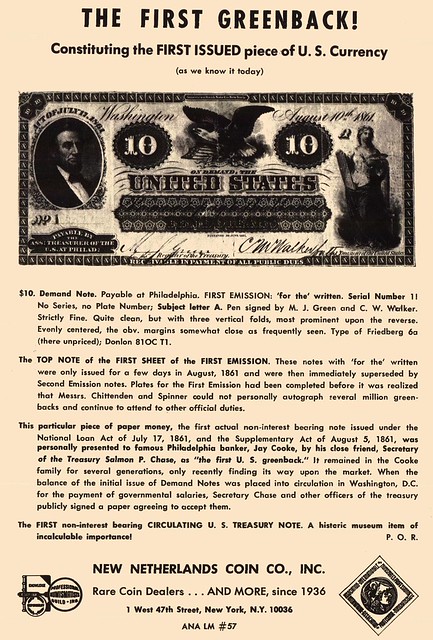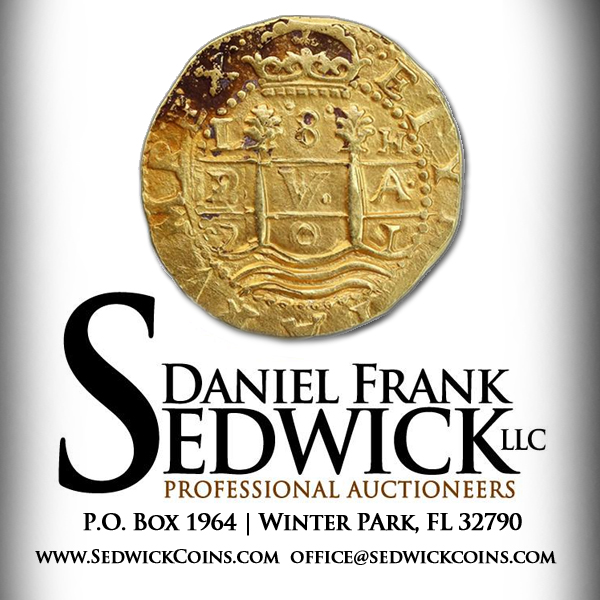
PREV ARTICLE
NEXT ARTICLE
FULL ISSUE
PREV FULL ISSUE
PROVENANCE OF THE VERY FIRST FEDERAL NOTESPeter Huntoon submitted this article following up on his search for the provenance of banknotes once owned by Secretary of the Treasury Salmon P. Chase. Thanks! -Editor
Provenance of the Very First Federal Notes My article in the June 2017 Bank Note Reporter tracking the provenance and whereabouts of the very first Federal notes that had been saved by Salmon P. Chase, Lincoln’s Secretary of the Treasury, resonated with a lot of people. As a result, I received some needed authoritative information that fleshes out the story. What we are talking about here are the following three notes:  Figure 1. First $10 1861 demand note, serial 1, plate position A. Photo courtesy of Jess Lipka.  Figure 2. First $1 1862 legal tender note, Series 1, serial 1, plate position A. Photo from Reinfeld (1960, p. 62) that he obtained from the Chase Manhattan Bank collection. John Rowe and Joe Sande independently collared me in quick succession within minutes of my arrival on the bourse floor of the June 2017 International Paper Money Show in Kansas City, to say they could correct and flesh out the stories of these notes. John had information pertaining to the number 1 $10 1862 demand note and Joe knew the whereabouts of the number 1 $1 1863 legal tender note. Martin Gengerke did an admirable job tracking the paths or at least the mentions in the numismatic literature of these three notes for his census of Federal notes, so I am reproducing his findings here as a starting point. ? Fr.17 - #1 $1 legal tender: Salmon P. Chase; George Blake; Chase Manhattan Bank; Hessler & Reinfeld Illus.  Figure 3. Bottom note from the first sheet of $5 national bank notes, Treasury sheet serial 9—the first Treasury serial used, bank sheet serial 1, plate position D with Chase’s handwritten “First national bank note issued, S. P. C.” on the back. Photo courtesy of Mark Hotz. I mentioned in my June piece that something didn’t ring true with the Sotheby 1970 sale attribution for both the $10 demand and $5 national bank notes. I was unsuccessful in locating a copy of any 1970 Sotheby sale containing the notes, even with the help of Gerome Walton who looked in the available catalogs in the ANA library in Colorado Springs. The cited Sotheby sale was key, so I thought to take advantage of another fabulous resource—the readers of The E-Sylum, the electronic publication of the Numismatic Bibiomania Society edited by Wayne Homren. The subscribers to it comprise a tenacious group of hardcore highly literate numismatists who simply revel in solving mysteries both numismatic and otherwise. “Otherwise” encompasses anything historical, genealogical, linguistic or scientific. I put out a call to them through The E-Sylum and that hunch paid off in spades. Tim Welo of New York graciously offered to look in the Sotheby’s catalogs in the American Numismatic Society library in New York City the next time he was in town. This he did but was unable to find the lots. Bryce Brown, a numismatic book dealer, also contacted me. He had in stock 1970 Sotheby catalogs as well as 1970 Parke-Bernet catalogs, a firm that became part of Sotheby’s soon after. He generously looked through all of them without finding the lots either. Be aware that neither Welo nor Brown know me, but they certainly went out of their way to help and spent plenty of their time doing so. These are the types of people who populate The E-Sylum distribution list, which, incidentally, is free. If you wish to subscribe, go to coinbooks.org The fly in the ointment in this tale was the involvement of John J. Ford, who owned the $10 demand note. After he came into possession of it, he offered it through a New Netherlands Coin Company ad in the January 1971 Numismatist. That ad is reproduced here. The attribution provided in the ad is a fabrication.  Figure 4 - Numismatist-1971-Jan-inside front cover Figure 4. Offering of the $10 demand note in the January 1971 issue of The Numismatist. Here is the provenance section in case you can’t read the reproduction. This particular piece of paper money, the first actual non-interest bearing note issued under the Act of July 17, 1861, and the Supplementary Act of August 5, 1861, was personally presented to famous Philadelphia banker, Jay Cooke, by his close friend, Secretary of the Treasury Salmon P. Chase, as ‘the first U. S, greenback.’ It remained in the Cooke family for several generations, only recently finding its way upon the market. Years later, when Martin Gengerke was compiling his census, Ford planted the 1970 Sotheby attribution for both the $10 demand and $5 national bank notes with him. By then the $5 national had been discovered. Trusting the world-renowned authority, Gengerke incorporated both attributions into the census without vetting them. John Rowe was actually there when the $10 demand note came in from the cold. It is a story that demonstrates that reality is stranger than fiction. Of all things, the note was offered through a Public Broadcasting Station fund raising auction held by Dallas TV station KEVA in the late 1960s. Someone had donated it and Rowe and Texas dealer Mike Brownlee purchased it. Rowe recalls that they attempted to place it through a discrete intermediary with a Washington, DC, area collector—probably Phil Lampkin—but he didn’t bite. It then passed into the hands of Ford, whereupon it appeared in the New Netherlands ad. Ultimately Lampkin purchased it. This was Ford’s connection with New Netherlands. Coin dealer Moritz Wormser (1878-1940) formed New Netherlands Coin Company in New York City in 1936. His son Charles (1911-1990), an associate of the company from the time of its founding, ran the firm after his father’s death. In 1950 Charles invited John J. Ford to assist him and he shortly became a full partner in running the business. The company closed in 1988. Lampkin was a savvy Washington, DC, area collector/dealer who liked high-end paper. Veteran DC area numismatist Julian Leidman, who knew Lampkin, doesn’t believe the $10 was in his possession when he died and his remaining notes passed to his daughter. The path that the note took after leaving Lampkin is shrouded in confidential transactions. It currently resides with a collector who wishes to remain anonymous. The numismatic origin story for the $5 national hasn’t changed much since I wrote the first article. However, purged from that account is the Sotheby connection. I recall John Hickman telling me that Lampkin claimed that the note had come down through Chase’s daughter’s family. At this juncture, I would classify this early history as likely but unverified. Regardless, Lampkin did come into possession of the note at about the same time or a little after the $10 demand note appeared. The next person on Gengerke’s roster for the $5 is Marc Watts, owner of the Gaithersburg Coin Exchange, in Maryland. He is said to have purchased the note from Lampkin’s daughter sometime after Lampkin died. The note then passed from Watts to BNR columnist Mark Hotz via a byzantine trade. The note resides with Hotz to this day. In my opinion, the $5 national heads the parade in terms of the appeal of the three Chase notes because in his own hand Chase penned on its back “First national bank note issued. S.P.C.” What more could you ask to tie a note to such history? What you can see here is that I have traced the $10 and $5 back to the late 1960s-early 1970s. Chase died in 1873 so we can assume they were in his possession until then. This leaves almost a 100- year gap that is hazy. It is easy to assume that they remained in Chase’s family, but one thing I know about assumptions in this game is that they are always wrong! The $1 legal tender note was the first of the three that we know definitively reached the numismatic market. Previously I wrote the following. There is no question that renown collector/dealer George Blake, who was an early ferret of fancy serial numbers, once owned the ace. Smith’s biography of Blake states that he exhibited paper money including a dollar bill Series 1, plate 1, serial 1, letter A” at the 1914 ANA convention. How he got it is unknown, but the timing of his involvement with it strongly indicates that the piece was the first to leave the Chase family. Whether Blake placed it with the Chase National Bank, forerunner to the Chase Manhattan bank, is unknown to me. It is likely because he circulated easily in New York banking circles as he pursued fancy serial numbers in new currency shipped to the New York banks and the Chase bank certainly would have had an affinity for the note. Telling is the fact that ‘On his last birthday, he [Blake] was featured on the advertisements of the Chase National Bank as its oldest living depositor’ (Numismatist, 1956). Currently the whereabouts of the $1 note is unknown. It was not in the Chase Manhattan Bank collection when that collection was transferred to the National Numismatic Collection at the Smithsonian Institution. Joe Sande, when he caught me at the 2017 International Paper Money Show at Kansas City, advised that the bankers at the Chase Manhattan Bank withheld the ace from the Smithsonian accession. It now resides in a small collection of historic treasures that are held by the bank in their corporate offices in New York. It is in an exhibit that is not accessible to the public that also includes the Hamilton-Burr dueling pistols, among other high-power objects. Of course, retaining ownership of the note by the bank makes all the sense in the world. The first U. S. $1 note complete with Chase’s portrait goes straight to the heart of the very identity of the bank. I should have anticipated that. We haven’t detailed every move these three notes have taken and my tale is not as thorough or robust as the wanderings documented for other premier numismatic objects such as the 1913 liberty head nickels. But that’s not all bad. Much of the romance of notes is the mystery that shrouds their travels. We now know enough about these three to titillate us. Maybe we just don’t need to know everything. I sure would like to know the wandering of the $10 demand note that took it to the KEVA fund- raising auction in Dallas though! Sources of Information Gengerke, Martin T., on demand, U. S. paper money records, a census of U. S. large size type notes: CD produced on order, gengerke@aol.com. New Netherlands Coin Co., January 1971, The first greenback!: The Numismatist, inside front cover. New Netherlands Coin Company: http://numismatics.org/archives/ark:/53695/nnan0082 Erlanger, Herbert J., March 1951, Metals of the New York Numismatic Club: The Numismatist, p. 271-272. The Numismatist, February 1956, Obituaries, George H. Blake, LM 150: p. 166. Reinfeld, Fred, 1960, A simplified guide to collecting American paper money: Hanover House, Garden City, NY, 128 Smith, Pete, 1992, American Numismatic Biographies, Blake, George H.: Gold Leaf Press, Rocky River, OH, p. 31. To read the earlier E-Sylum articles, see:  Wayne Homren, Editor The Numismatic Bibliomania Society is a non-profit organization promoting numismatic literature. See our web site at coinbooks.org. To submit items for publication in The E-Sylum, write to the Editor at this address: whomren@gmail.com To subscribe go to: https://my.binhost.com/lists/listinfo/esylum All Rights Reserved. NBS Home Page Contact the NBS webmaster 
|